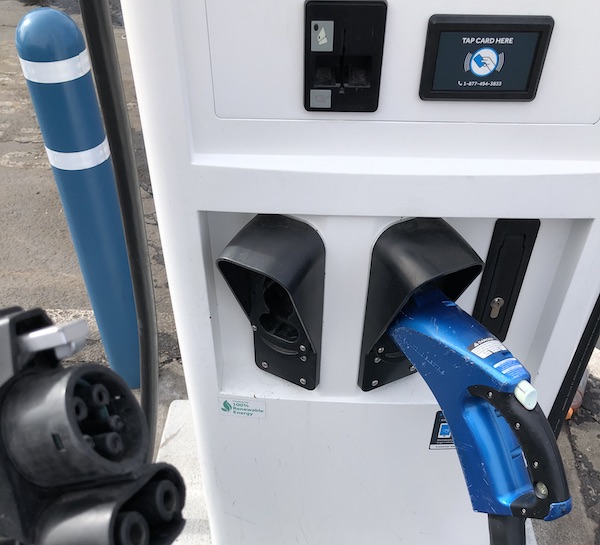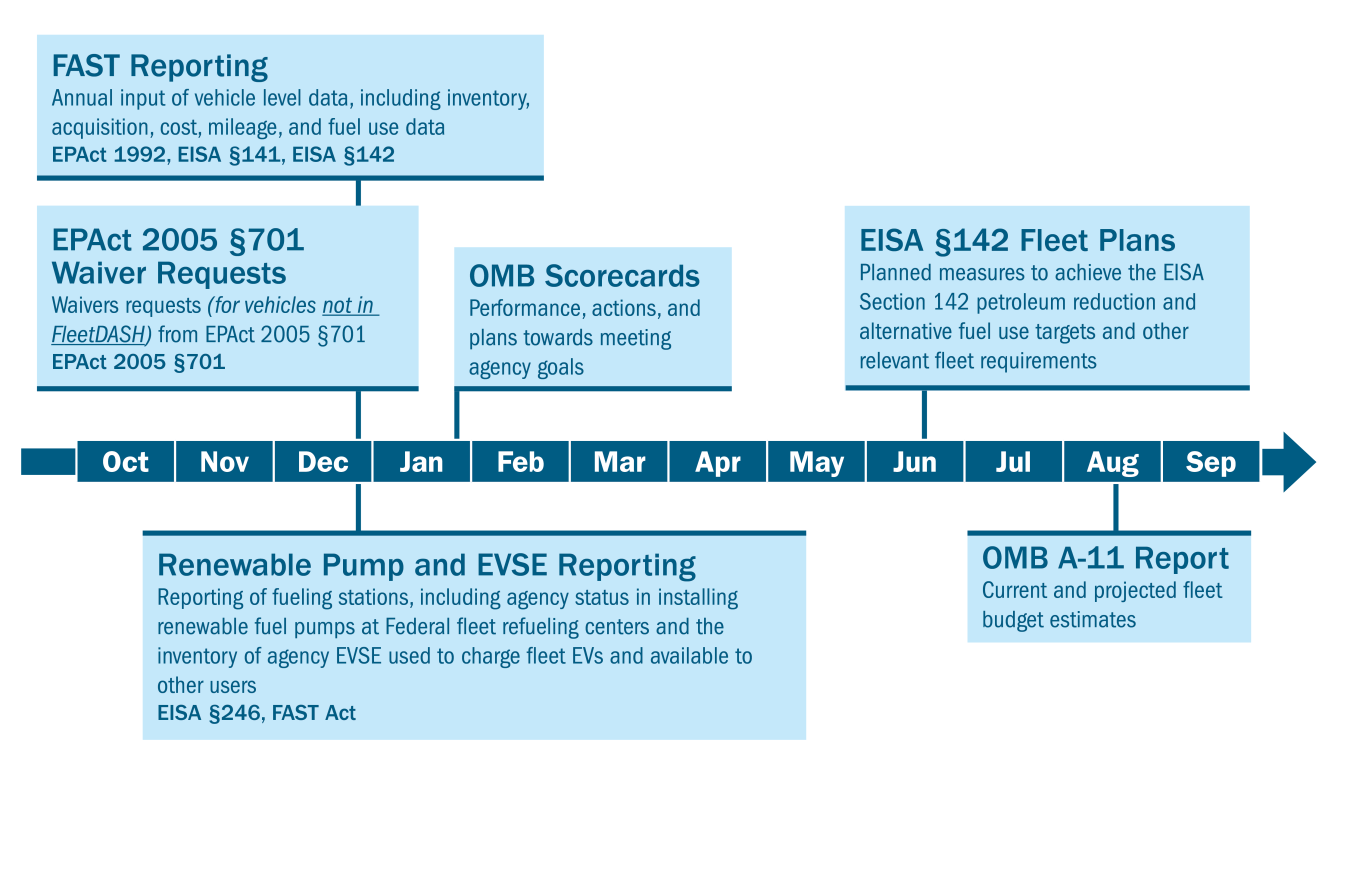Summary of Reporting Requirements
The collection, management, and analysis of comprehensive fleet data supports the calculation of agency performance in meeting the following requirements:
- Energy Independence and Security Act (EISA) of 2007 Section 142 petroleum reduction and alternative fuel use increase
- Energy Policy Act (EPAct) of 1992 AFV acquisitions
- EPAct 2005 alternative fuel use in dual-fueled vehicles
- EISA Section 246 renewable fuel infrastructure reports
- Electric vehicle supply equipment (EVSE) installation reports per Public Law No. 114-94, Fixing America's Surface Transportation Act (the "FAST Act" of 2015)
- EISA Section 141 low greenhouse gas (GHG)-emitting vehicle acquisition
These data also enable agencies to optimize fleet decision making in identifying the most promising fleet strategies to reduce petroleum consumption. Fleet managers can use fleet data to evaluate their performance in meeting fleet requirements and the effectiveness of petroleum reduction strategies at each fleet location. These analyses can help determine areas where the fleet has been successful as well as identifying the greatest opportunities to improve performance.

Electric Vehicle and Electric Vehicle Supply Equipment Reporting
Explore best practices for measuring and reporting electric vehicle charging.
Target Audience Responsibilities: Annual FAST Reporting
Agency Chief Sustainability Officers are responsible for monitoring agency performance and providing information and progress reports as required by CEQ and OMB.
Agency headquarter fleet managers are responsible for completing the annual collection and reporting of fleet data in FAST. This includes establishing a reporting structure (or reporting hierarchy) to delegate individual fleet data collection and reporting responsibilities to fleet location managers. The headquarters fleet manager is ultimately accountable for ensuring fleet data for all individual fleet locations are populated and managed in an agency FMIS, as well as reviewing data for completeness and accuracy, and correcting data as necessary in the system.
Agency fleet location managers are responsible for providing the agency headquarters fleet manager complete and accurate data throughout the year in support of the annual agency reporting requirements.
Annual Reporting Timeline
The fiscal year begins with the annual input of vehicle inventory, acquisition, cost, mileage, and fuel use data for the previous fiscal year in the Federal Automotive Statistical Tool (FAST) from roughly October 1 through December 15. Before the beginning of the FAST data call, agencies should ensure that their reporting hierarchy has been established and updated as necessary, any new users should be added, and old users removed.
| Annual Federal Fleet Planning, Reporting, and Management Requirements | |||
|---|---|---|---|
| Timeframe | Report | Statute or Executive Order | Requirement |
| Approximately October 1–December 15 | FAST Year-End Reporting | EPAct 1992 | Annual input of vehicle inventory, acquisition, cost, fuel use, and mileage data Annual input of EISA Section 246 alternative fuel infrastructure and FAST Act of 2015 EVSE installation data Federal agencies identify vehicles for automatic waivers or apply for a waiver from the requirement to use alternative fuel in all agency dual-fueled vehicles |
| EPAct 2005 | |||
| EISA § 141 | |||
| EISA § 142 | |||
| EISA § 246 | |||
| FAST Act | |||
| January | Office of Management and Budget (OMB) Scorecards | EISA § 142 | Agency progress toward achieving fleet management sustainability goals |
| June 30 | EISA Section 142 Fleet Plan | EISA § 142 | Specific measures the agency will implement to achieve the EISA Section 142 petroleum reduction and alternative fuel use targets and other relevant fleet requirements |
| August | OMB A-11 Annual Fleet Budget Summary | Budget and Accounting Act | Budget estimates of current FY, as well as future fleet inventory and operating costs and fleet management plans |
Asset-Level Data
Each agency must ensure its fleet management information system (FMIS) can support the collection and management of asset-level data (ALD), including importing data from vehicle telematics and exporting ALD to support government-wide reporting systems. To support ALD reporting, a vehicle-level data element reference, a vehicle-level data business rules reference, and the vehicle-level data XML schema (a structure for XML data submissions) are available for download from FAST. An agency's FMIS should be based at the department or agency headquarters level and include all motor vehicles within the department or agency. The system should also include reporting and accountability structures to accommodate subordinate regional and field offices.
As part of annual data reporting in FAST, agency headquarters managers upload data from the agency FMIS to FAST using a standardized file structure, which includes vehicle inventory, acquisition, disposal, cost, mileage, and fuel use information for each vehicle. All data fields are attributed to individual vehicles and fueling transactions for each of those vehicles. Each data field includes business rules to help identify potential errors, by either blocking data that simply cannot be valid or flagging data that are outside of bounds that may be valid for a typical Federal fleet vehicle.
Agency headquarters fleet managers, with assistance from fleet location managers, should review and correct (if necessary) data that fails FAST flagging rules in the agency FMIS and upload the corrected data set into FAST. Once the agency fleet manager is satisfied with the quality, accuracy, and completeness of fleet data uploaded into FAST, the agency fleet manager can certify the annual data reporting is complete.
Reporting ALD simplifies the annual reporting process by enabling uploads from fleet management systems directly to FAST without requiring manual data aggregation, reducing errors and drastically decreasing manual data entry. Compared to historical FAST reporting, ALD provides significantly more detailed data, allowing for improvements in fleet analysis, optimization, and management as well as compliance oversight. In the long term, this is designed to significantly reduce the reporting burden on agencies.
Federal Fleet Fueling Center Reporting
 Federal agencies subject to EPAct requirements must report data on their Federal fleet fueling centers via FAST not later than mid-December of each calendar year. Agencies must complete all fields in the report, including the Federal fleet fueling center name, its location, and fuel types available at that station. Agencies should report all of their stations in existence at the end of the preceding fiscal year and note if the station is temporarily unavailable.
Federal agencies subject to EPAct requirements must report data on their Federal fleet fueling centers via FAST not later than mid-December of each calendar year. Agencies must complete all fields in the report, including the Federal fleet fueling center name, its location, and fuel types available at that station. Agencies should report all of their stations in existence at the end of the preceding fiscal year and note if the station is temporarily unavailable.
Agencies may download a Microsoft Excel template from FAST. Beginning in 2021, the template will contain information about an agency’s previously reported fueling centers. That template can be filled with updated information about those fueling centers, along with the required information for any new fueling centers or fueling centers not previously reported. Once filled in, the agency can reload this template into FAST. Also, the Excel template has a second tab dedicated to EVSE. For more detailed guidance on FAST reporting, please refer to Idaho National Laboratory's FAST Fueling Infrastructure Reporting FAQs.
Each year, the Federal Energy Management Program (FEMP) compiles this information on the status of agency performance in complying with the renewable fuel pump installation requirements. The EVSE portion of the report is used to determine compliance with the FAST Act requirements for employees to reimburse agencies for electric vehicle workplace charging. The information is also populated in the Alternative Fuels Data Center Station Locator database to identify alternative fuel availability for the Section 701 alternative fuel use requirements.
GSA FMR Federal Management Information System
40 U.S.C. §§ 17502 and 17503 require that each Federal agency must have a federal management information system (FMIS). The General Services Administration (GSA) Federal Management Regulation (FMR) § 102-34.340 provides more specifics on what should be included in an FMIS including that it:
- "Identifies and collects accurate inventory, cost, and use data"
- "Provides the information necessary to satisfy both internal and external reporting requirements"
- Collects all costs incurred in the operation, maintenance, acquisition, and disposition of motor vehicles used for official purposes
- Is capable of providing the data required for external reporting, such as FAST.
More detailed discussion of this requirement is available in GSA's FMR Bulletin B-15. The agency FMIS facilitates ALD management and serves as a critical tool for controlling costs, establishing utilization criteria, and ensuring effective fleet resource management. Agencies that do not have an existing, compliant FMIS are encouraged to use GSA FedFMS, for no additional cost.



